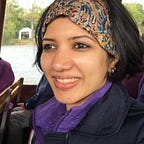Listening to the earth
Puhpowee, ‘the force which causes mushrooms to push up from the earth overnight’, writes Robin Wall Kimmerer in her book, Braiding Sweetgrass, translating from Anishinaabe, an indigenous language with a strong concentration around the Great Lakes.
Over the past few weeks, I find myself returning to this word as I walk everyday in a forest in the Dhauladhars. On each trail, forest markers have emerged that serve as guiding points, bringing with them a familiarity and comfort that comes with recognition — a gnarled moss-covered stump, a fallen tree supported by its fellows, a bend where the gush of the river suddenly becomes part of the soundscape.
One of the markers I look to on these walks is a snag (a term used in forest ecology to describe a standing, dead or dying tree). When we first crossed paths at the end of the summer, it was bereft of leaves, its bare branches reaching into the sky. As the weeks passed and with the onset of the monsoon, I watched as it underwent a steady transformation. A feathery moss, spongy to the touch, began to grow on its trunk, slowly making its way upward along the branches in a green-and-brown ode to the rain and everything it touched. On the lower reaches, two kinds of ferns enfolded the trunk while a fan-shaped fungi began making its way along the upper reaches. Every day, more would appear, spreading and extending their network, pushing up from the wood, silent design at work.
Puhpowee
Kimmerer writes in her book: ‘In the three syllables of this new word I could see an entire process of close observation in the damp morning woods, the formulation of a theory for which English had no equivalent. The makers of this word understood a world of being, full of unseen energies that animate everything.’ Each day as I walk, I see evidence of these unseen energies — barberries turning from green to purplish-blue and ripe for the picking, yellow buttercups that marked the summer giving way to wild violet petunias, moss growing in the crevices between bricks, leeches clinging to warm blooded hosts. It’s as if the earth is bursting with life, rising up, emerging and carrying with it an invitation to be. There’s a dynamism and inner spontaneity that is perceptual, a felt sensation in the body.
I think of language, alphabetised civilisation in particular, and how limiting it is in giving voice to this life force that is pulsing through all animate beings — mushroom, rock, stream and wood. Kimmerer writes of how English grammar delineates between human and non-human, designating the latter as an ‘it’. She describes another way of inhabiting the world through the grammar of animacy, a state of being alive and sentient. The indigenous Potawatomi tribe to which she belongs extends this language to all living beings and in doing so serves as a reminder of our kinship with the animate world. ‘Saying it makes a living land into “natural resources.” If a maple is an it, we can take up the chain saw. If a maple is a her, we think twice,’ she writes.
Since April, I’ve been living away from the city, in quieter, green spaces where there is room to be outdoors, to walk, to stare into the sky. It has made space to re-remember connections to the earth that feel older than this lifetime, embedded in the primordial — an instinctive participation with the living land. Reading Kimmerer in this this time-of-life also feels potent, an invitation to give voice to something felt but difficult to express. In the grammar of animacy, in greeting the trees as Tree People, as a who and not an it, the world becomes richly inhabited. The very otherness of interaction with intelligences that are different from the human kind creates a sense of intimacy with the surrounding world. Science now points to as much through studies of the ‘wood wide web’ and how trees communicate with each other through complex underground fungal networks, reiterating their web of alliances and kinship networks that were once considered non existent. Is it so hard to imagine then that all beings communicate in multiple ways through the sensory and sensuous?
‘In English, we never refer to a member of our family, or indeed any person, as it. That would be a profound act of disrespect. It robs a person of selfhood and kinship, reducing a person to a mere thing,’ writes Kimmerer. I’m struck by her observation and of how easily we relegate other species and life forms to non-human and therein of less importance. With it follows acts of neglect and harm that are evident even in the forest and by the river in the shape of carelessly discarded waste, speakers blaring at full volume and denuded mountain slopes that then threaten life and limb through landslides which are on the rise every year. I wonder if rethinking language, at how we choose to look at and understand the world, and recognising the sentience of other living beings can change this story of harm.
When I’m able to quieten, it feels as if the world around me is alive and aware, that language of a different kind being communicated through sound or sensation — in the way raindrops drip from pine needles and meet the forest floor covered in leaves or the way the river races over the rocks. It seems like a simple, obvious start to reestablish long forgotten relationships with the earth. At a time when distance from other humans is prescribed for physical safety, it feels even more urgent and necessary to turn to other animate beings, to listen and be held by the wisdom they offer.
